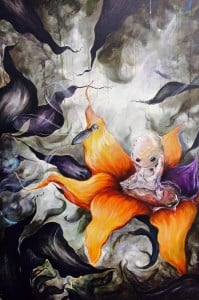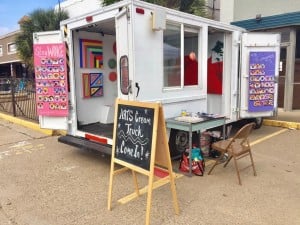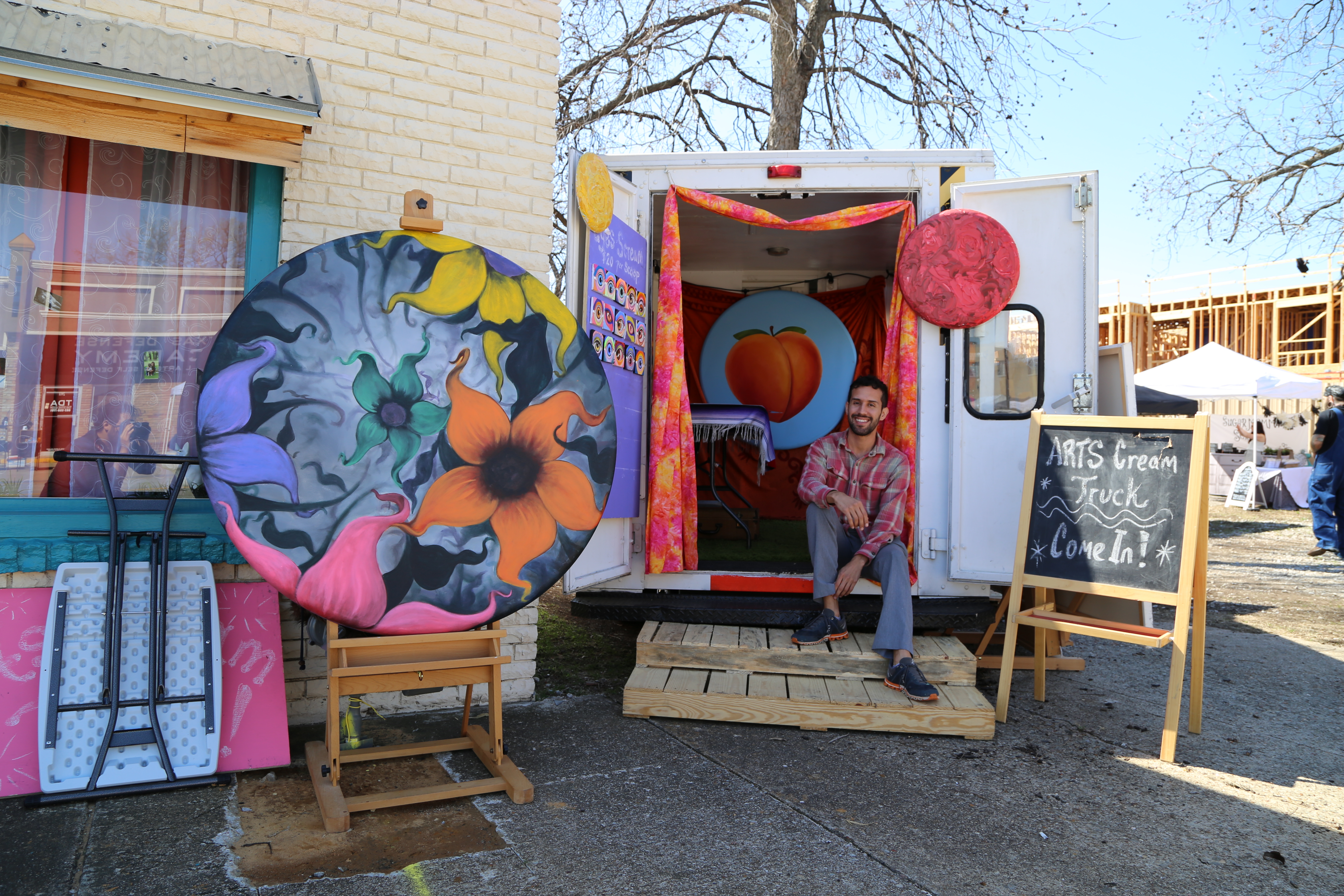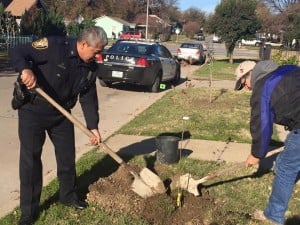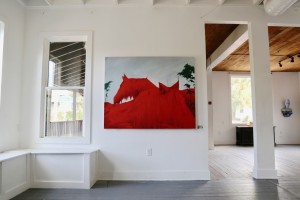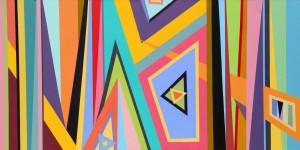Hey! Look! It’s The ArtsCream Truck!
ArtandSeek.net April 5, 2018 259Welcome to the Art&Seek Artist Spotlight. Every Thursday, here and on KERA FM, we’ll explore the personal journey of a different North Texas creative. As it grows, this site, artandseek.org/spotlight, will eventually paint a collective portrait of our artistic community. Check out all the artists we’ve profiled.
Museums are looking for ways to get diverse audiences in the door and make new visitors feel comfortable. But painter Arnoldo Hurtado has another idea. In this week’s Artist Spotlight, Art&Seek jumps into a mobile art gallery aimed at bringing art to the people.
Arnoldo Hurtado is a man on the move. And he gets around in big white truck.
“Yea, so we’re riding around it and (laughs) it’s a refurbished ice cream truck,” Hurtado says with a grin on his face and his hands on the wheel. “Before that, it used to be a mail truck, mail carrier. Fed-Ex type.”
Instead of ice cream or packages though, Hurtado’s truck is filled with paintings.
“I got it in Pensacola, Florida,” he continues. “Found it on Craigslist, went and picked it up, and I’ve slowly turned it into a mobile art experience. I just take it to random corners of the city and open it up and share the art with people. It’s my art.”
He calls the thing his ArtsCream Truck. Inside, massive paintings and colorful tapestries hang on the walls and lights dangle from the roof. He places prints, tiny watercolor paintings and even little sculptures on small tables.
Hurtado says he’s a classically trained painter, “I did portraits at an early age. Landscapes, Texas landscapes with bluebonnets and all that stuff. But there came a point where I was like, ‘Ah!’ you know, ‘I’m done with landscapes.’
The 29-year-old Fort Worth native graduated from the painting and drawing program at University of North Texas. But he’s switched gears.
“And now I’m doing surreal works. So surreal landscapes, surreal creatures… Things I create in my imagination, so hybrid, sort of embryonic fruits. I do a lot of everything. You know, I don’t limit myself,” says Hurtado .
Hurtado’s evolved from a visual artist to an activist, or a social practice artist.
See, at first, the ArtsCream Truck was just a way for Hurtado to show and sell his work. He felt constricted by the gallery scene. Then, he took the truck to a Latino neighborhood in Austin. The reaction made him see the truck differently.
“They came up to the truck and they were curious and they asked me in Spanish, ‘What’s going on?’ I told them that I was part of the EAST Austin Studio Tour and they didn’t know what that was,” Hurtado says.
Those people had lived in the neighborhood for years. And the Studio Tour had been happening for years. But there was no interaction.
“They weren’t being reached,” explains Hurtado.
That disconnect reminded him of home. Hurtado grew up on Fort Worth’s Northside in a working-class neighborhood of mostly Spanish speaking families. His street – Northwest 27th – had issues.
“There was a house right next to us that had fights all the time,” Hurtado says. ” [And there were] these piles of couches and trash all around, feces, people living in tents in the front. It was ridiculous. It was out of control.”
So three years ago, Hurtado began knocking on doors and talking to people. He realized others saw the same problems.
“And I was like, ‘Why aren’t talking about this? Why aren’t we reaching out to each other?” says Hurtado.
He started Comunidad 27 – a group of neighbors who plant trees, throw potlucks for the Fort Worth Police Department and host Latin Christmas Festivals.
Now, Hurtado says it’s time make the North side a cultural destination.
“It’s like, ‘Hey! We can do this too.’ If we’re not going to get funding or backing from the city to do this, we’re going to do it ourselves because we have that kind of power,” he says.
The ArtsCream Truck was phase one. Phase two is a mural project called “Convivio: Murals of Community and Inclusion.” Hurtado’s convinced local businesses to fork over wall space. And he’s finding neighborhood talent too.
“So the point is to really get the community involved and invested in their own community by participating in the murals,” says Hurtado.
Hurtado wants to turn the North Side into a kind of outdoor gallery, which shows off the talent of his neighbors. He knows the region’s finest art museums are just a few miles away. But he believes there’s room for more than one cultural district in Fort Worth.
How does North Texas effect the production of your art?
Well, because I am so socially aware (laughs), I’d have to say I’m understand North Texas’ culture. Cause you know, it’s different than Austin or whatever. And I definitely respond the culture. It effects how I approach art, what I paint and even how I approach people.
I feel as though there are gaps that need to be filled – in terms of culture and art. Like I felt like accessibility to those things were missing in the area I was raised in, and so I’m the person who’s trying to take care of that. And I am talking with people about how they can contribute too.
Arnoldo, you’ve worked to unite your neighbors. You’ve founded Comunidad 27 and together you’ve cleaned up streets, planted trees and helped decrease crime. Now, you’re using a food truck that you’ve transformed into a mobile art gallery to bring artwork into underserved communities. Why? Why do you think the responsibility of an artist is to his/her community?
I can’t speak about what other artists should be doing, but I can speak for myself. For me, I have the knowledge of what I am good at and I know what I am actually able to do. I know my strengths. And my strengths are talking to people, getting to know them and making art. So for me, it was like, ‘Why not?’
We’re definitely living and working in an oppressive society. And I see that. I see the systemic oppression that people don’t want to talk about. But I call it out. I’m passionate about that. That’s why I am always talking about it. But beyond talking about oppression, I want to do something. You know? I think now – more than ever – is the time to start doing something.
I think more people can do this too. People are capable. But I think we buy into narratives. We buy into the narratives that we need to work a certain amount of hours and live a certain kind of life… But you can write your own narrative. That’s what I’m doing for myself. And I hope that I helping others to write their own narrative.
I’m sure that you’re asked about your social practice artwork all the time. But can you tell me about your paintings?
I do acrylic paintings, mostly on canvas, and I was classically trained. I did a lot of portraits and landscapes. Lot of Texas landscapes with bluebonnets and such. But then there became a point when I was like, ‘I’m done with the traditional stuff.’ And now I am doing surreal work. Surreal landscapes, creatures and things that I create. Think hybrid, embryonic fruits and a lot of nature that looks like that.
I also like to paint nature. I recently did a painting of red horses covered in moss. I think Texans were excited to see the horses. Even if they were covered in a red moss and a made up landscape.
I also do a bit of colorful abstract work. I paint a lot of everything. I don’t limit myself. I mean, I drive a truck around full of paintings. Some of them are cohesive and some of them are just random. And I’m okay with that.
Arnoldo, you’re work is being shown inside of a truck. Some people show in a gallery. Who is the target audience for your paintings? And where would you like for it to be seen?
I think my artwork can be shown anywhere. I think artwork can be anywhere. But my work specifically can be in a gallery, but right now my calling is in the streets. And there’s a bigger audience in the streets. Probably not the kind that would go inside an art gallery and buy artwork, because galleries are very intimidating to people. They carry the stigma of being exclusive.
So I am approaching it from the this perspective: Let me make what I want to make. I’ll put it in the truck. And people want to walk up to the truck (which they do), they’ll see it.
How do you maintain balance in your life?
I have a lot interests. I love traveling. I love making art. I love meeting and interacting with people. And I’ve become pretty good at listening to myself. If I need to work out, be social or make art – I do it. So I just try to keep being aware.
When did you start calling yourself an artist?
I think I started thinking of myself and calling myself an artist four years ago. I was teaching and there was something about being able to communicate what I do to my students helped. You need to be able to tell people what you do. You need to be able to own it. It’s important.
I know there are people who don’t look at artists as people who contribute to society. And I think students are aware of that. So being able to explain my artwork to them and being able to talk with them really solidified it.
Are you creatively satisfied?
YES! I am SO SATISFIED. I am actually at the point where I am reaching for more.
So I’m satisfied in the sense that I’ve reached a level where I am happy. But I know there’s going to be more. Right now I am really really really happy. But I am excited for more.
Have you had to give anything up to be an artist?
I had to give up my job. I was giving 100-percent of myself to teaching. And I loved it. But I knew there was still more that I wanted to be doing. I wanted to be a student again. Just not necessarily in a higher institution. I wanna be out there on the road. I wanna be meeting people. And I wanna learn lessons. So that’s what I am doing.
What inspires you?
The people. The community. My family. Seeing how there’s a need for creativity, color, adventure and someone to show them how… That inspires me.
I think I am that example. I think I am adding color to my community. And I am happy. And I think that makes other people happy.
What makes you different from other artists in North Texas?
Look, I don’t pretend to know all the artists in North Texas. I’m a creature of habit, so chances are that I hang out with all the same folks in all the same places all the time.
But what makes me different is that I don’t think I am different. I think my mobile art gallery is different. And I think there’s a place for me here. I am putting myself out on the streets. I am challenging the ideas of institution. And I am bringing art to people who may not necessarily seeing art. Maybe it’s because it’s not in their neighborhood or they think it’s elitist, but I am bringing it to them. And I don’t think anyone else is doing it exactly the same.
Interview questions and answers have been edited for brevity and clarity.



